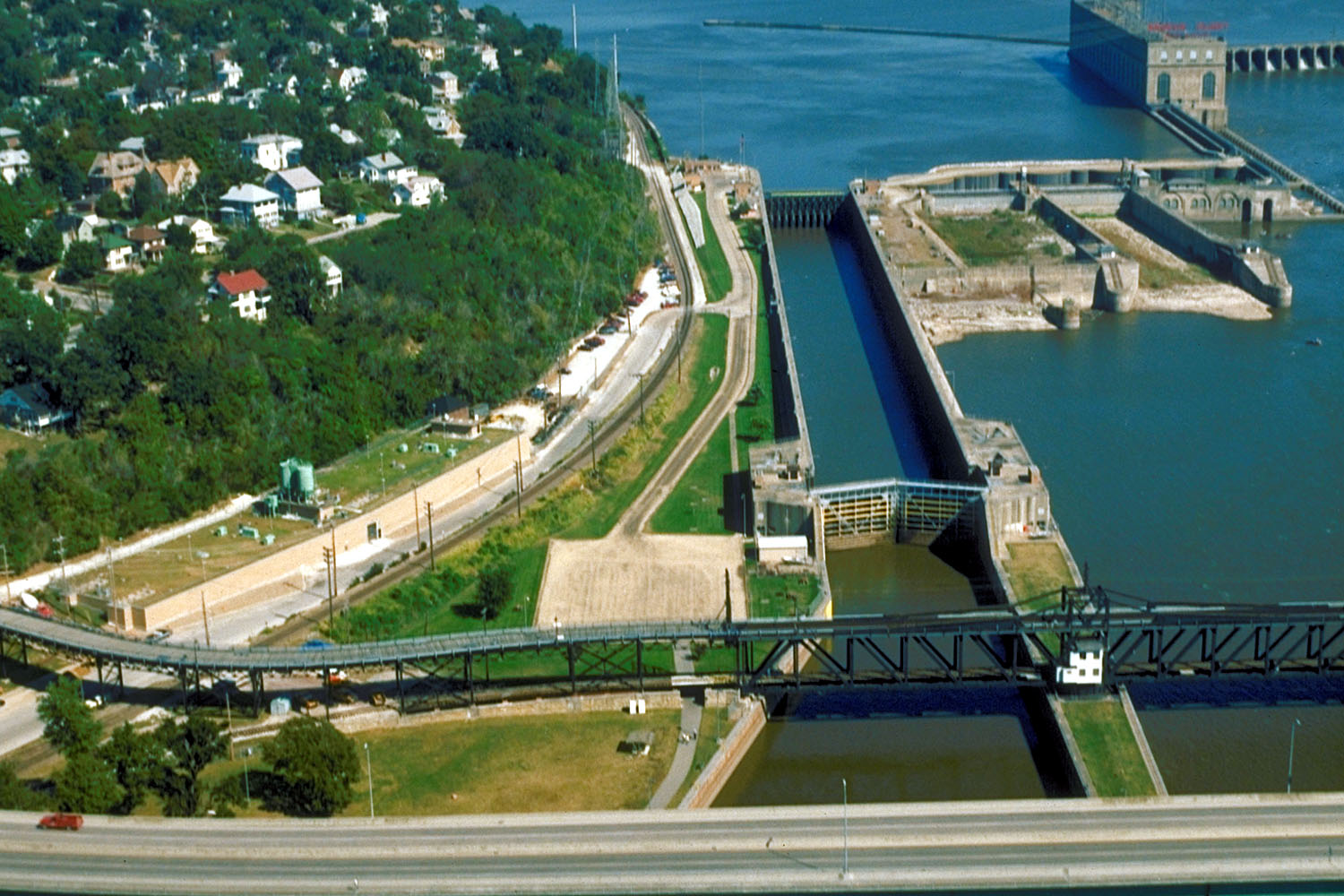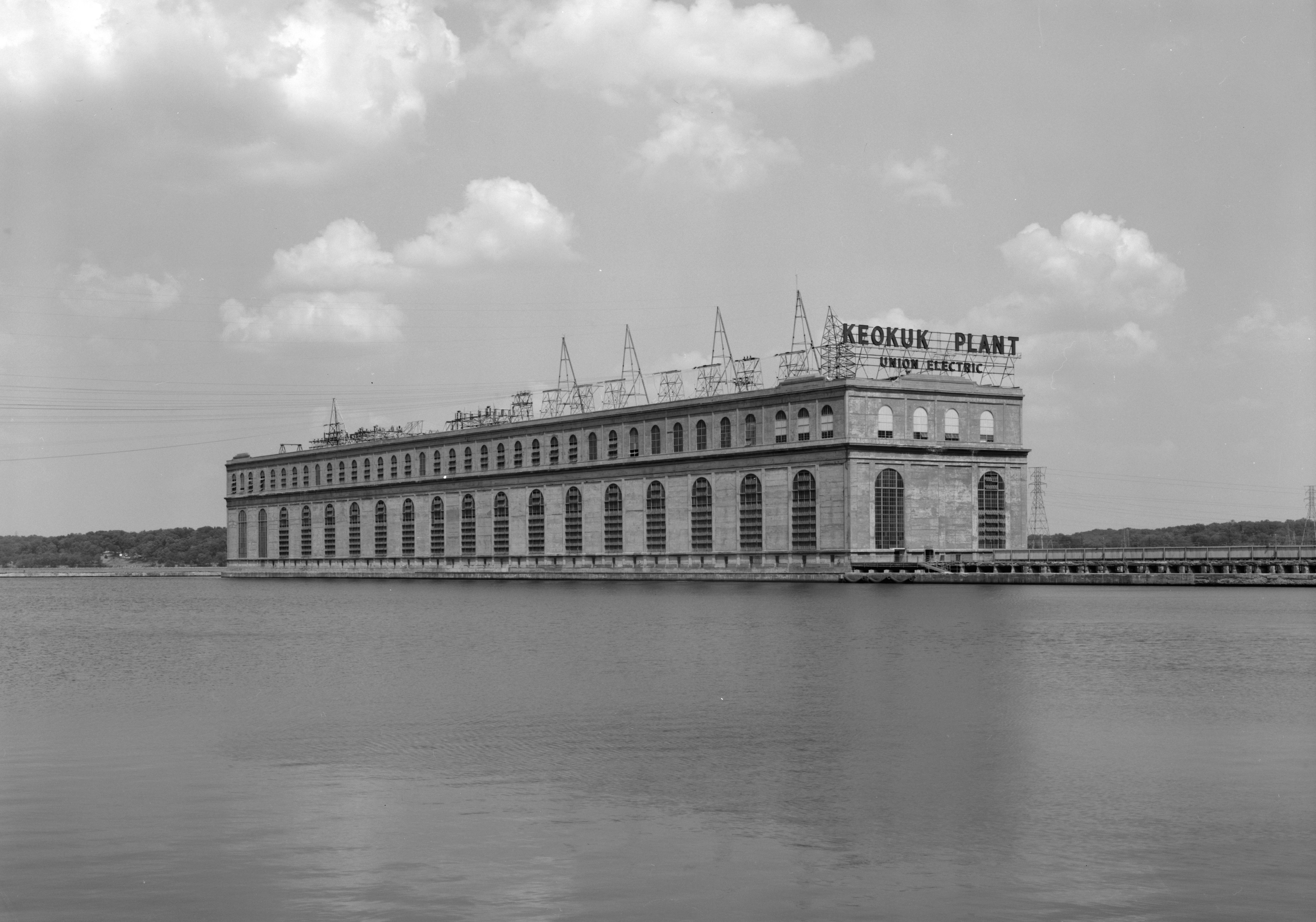Lock and Dam No. 19 on:
[Wikipedia]
[Google]
[Amazon]
Lock and Dam No. 19 is a
 The main lock was constructed from 1952 to 1957 and is long and wide with a lift of just over and large enough to handle a full-length tow of barges. It was put into operation in 1957 at a cost of 13.5 million dollars. The 1957 lock replaced a 1910-1913 lock. The 1913 lock was a variant of the standardized
The main lock was constructed from 1952 to 1957 and is long and wide with a lift of just over and large enough to handle a full-length tow of barges. It was put into operation in 1957 at a cost of 13.5 million dollars. The 1957 lock replaced a 1910-1913 lock. The 1913 lock was a variant of the standardized
 Construction of the dam began in 1910, and was completed in 1913. The movable portion of the dam is long with 119 separate rectangular, steel-skin plated, sliding gates. The gates are either installed or removed and river flow is controlled by the number of gates installed. They are removed by a gantry crane that travels on the service bridge above the dam. At the time it was completed it was second in length only to the
Construction of the dam began in 1910, and was completed in 1913. The movable portion of the dam is long with 119 separate rectangular, steel-skin plated, sliding gates. The gates are either installed or removed and river flow is controlled by the number of gates installed. They are removed by a gantry crane that travels on the service bridge above the dam. At the time it was completed it was second in length only to the
 Construction began in 1910 and when completed in 1913 it was the largest capacity, single powerhouse electricity generating plant in the world. The Power House and spillways are owned and operated by Ameren Missouri and has a 142 MW capacity. The powerhouse contains 15 generators, originally designed to produce 25 Hz instead of the 60 Hz
Construction began in 1910 and when completed in 1913 it was the largest capacity, single powerhouse electricity generating plant in the world. The Power House and spillways are owned and operated by Ameren Missouri and has a 142 MW capacity. The powerhouse contains 15 generators, originally designed to produce 25 Hz instead of the 60 Hz
 *
*
Lock No. 19 - U.S. Army Corps of EngineersAmeren Missouri Fact SheetHugh L. Cooper speaks to MIT civil engineers Jan. 1915
{{Lee County NRHP Buildings and structures in Hancock County, Illinois Buildings and structures in Lee County, Iowa Mississippi River locks National Register of Historic Places in Lee County, Iowa 19 19 19 Keokuk, Iowa Dams in Iowa Historic American Engineering Record in Illinois Historic American Engineering Record in Iowa Transportation buildings and structures in Lee County, Iowa Tourist attractions in Lee County, Iowa United States Army Corps of Engineers dams United States power company dams Gravity dams Dams on the Mississippi River Mississippi Valley Division National Register of Historic Places in Hancock County, Illinois Historic districts on the National Register of Historic Places in Iowa Hydroelectric power plants in Iowa 19
lock
Lock(s) may refer to:
Common meanings
*Lock and key, a mechanical device used to secure items of importance
*Lock (water navigation), a device for boats to transit between different levels of water, as in a canal
Arts and entertainment
* ''Lock ...
and dam
A dam is a barrier that stops or restricts the flow of surface water or underground streams. Reservoirs created by dams not only suppress floods but also provide water for activities such as irrigation, human consumption, industrial use ...
located on the Upper Mississippi River
The Mississippi River is the second-longest river and chief river of the second-largest drainage system in North America, second only to the Hudson Bay drainage system. From its traditional source of Lake Itasca in northern Minnesota, it fl ...
near Keokuk, Iowa
Iowa () is a state in the Midwestern region of the United States, bordered by the Mississippi River to the east and the Missouri River and Big Sioux River to the west. It is bordered by six states: Wisconsin to the northeast, Illinois to th ...
. In 2004, the facility was listed in the National Register of Historic Places
The National Register of Historic Places (NRHP) is the United States federal government's official list of districts, sites, buildings, structures and objects deemed worthy of preservation for their historical significance or "great artistic ...
as Lock and Dam No. 19 Historic District, #04000179 covering , 7 buildings, 12 structures, 1 object. The lock is owned and operated by the U.S. Army Corps of Engineers
, colors =
, anniversaries = 16 June (Organization Day)
, battles =
, battles_label = Wars
, website =
, commander1 = ...
. The dam is owned and operated by Ameren Missouri.
The lock and dam obliterated the Des Moines Rapids
The Des Moines Rapids between Nauvoo, Illinois and Keokuk, Iowa-Hamilton, Illinois is one of two major rapids on the Mississippi River that limited Steamboat traffic on the river through the early 19th century.
The rapids just above the con ...
which had effectively been the northern barrier for traffic on the Mississippi until efforts began in 1837 to address the Mississippi's depth in the rapids.
Locks
 The main lock was constructed from 1952 to 1957 and is long and wide with a lift of just over and large enough to handle a full-length tow of barges. It was put into operation in 1957 at a cost of 13.5 million dollars. The 1957 lock replaced a 1910-1913 lock. The 1913 lock was a variant of the standardized
The main lock was constructed from 1952 to 1957 and is long and wide with a lift of just over and large enough to handle a full-length tow of barges. It was put into operation in 1957 at a cost of 13.5 million dollars. The 1957 lock replaced a 1910-1913 lock. The 1913 lock was a variant of the standardized Panama Canal
The Panama Canal ( es, Canal de Panamá, link=no) is an artificial waterway in Panama that connects the Atlantic Ocean with the Pacific Ocean and divides North and South America. The canal cuts across the Isthmus of Panama and is a condui ...
design and was wide, long and tall with a lift. There was a wide, long and deep dry dock at the site, both the dry dock and 1913 lock were dewatered in 1977 when a sheet pile and cell closure were built blocking the upstream sides of the lock and dry dock.
The lock and dam, as well as the rest of the river, can be viewed from a distance on the Observation Deck of the Keokuk Rail Bridge
The Keokuk Bridge, also known as the Keokuk Municipal Bridge, is a double-deck, single-track railway and highway bridge across the Mississippi River in the United States between Keokuk, Iowa, and Hamilton, Illinois, just downstream of Mississip ...
.
Dam
 Construction of the dam began in 1910, and was completed in 1913. The movable portion of the dam is long with 119 separate rectangular, steel-skin plated, sliding gates. The gates are either installed or removed and river flow is controlled by the number of gates installed. They are removed by a gantry crane that travels on the service bridge above the dam. At the time it was completed it was second in length only to the
Construction of the dam began in 1910, and was completed in 1913. The movable portion of the dam is long with 119 separate rectangular, steel-skin plated, sliding gates. The gates are either installed or removed and river flow is controlled by the number of gates installed. They are removed by a gantry crane that travels on the service bridge above the dam. At the time it was completed it was second in length only to the Aswan Low Dam
The Aswan Low Dam or Old Aswan Dam is a gravity masonry buttress dam on the Nile River in Aswan, Egypt. The dam was built at the former first cataract of the Nile, and is located about 1000 km up-river and 690 km (direct distance) sou ...
on the Nile River.
Powerhouse
 Construction began in 1910 and when completed in 1913 it was the largest capacity, single powerhouse electricity generating plant in the world. The Power House and spillways are owned and operated by Ameren Missouri and has a 142 MW capacity. The powerhouse contains 15 generators, originally designed to produce 25 Hz instead of the 60 Hz
Construction began in 1910 and when completed in 1913 it was the largest capacity, single powerhouse electricity generating plant in the world. The Power House and spillways are owned and operated by Ameren Missouri and has a 142 MW capacity. The powerhouse contains 15 generators, originally designed to produce 25 Hz instead of the 60 Hz alternating current
Alternating current (AC) is an electric current which periodically reverses direction and changes its magnitude continuously with time in contrast to direct current (DC) which flows only in one direction. Alternating current is the form in whic ...
used today. Keokuk and Hamilton Water Power landed contracts in 1910 to deliver 44.7 MW of electricity to three customers located in St. Louis, MO (more than 100 miles downstream), at a time when no electric power had been transmitted more than a few miles: The Union Electric Light and Power Company, Laclede Gas Company and United Railways Company, which operated the St. Louis Street Railway Company. Union Electric Co. purchased the facilities in 1925. The 25 Hz generators powered industrial customers and used for the Streetcars in St. Louis, Missouri.
After World War II
World War II or the Second World War, often abbreviated as WWII or WW2, was a world war that lasted from 1939 to 1945. It involved the vast majority of the world's countries—including all of the great powers—forming two opposing ...
, a number of modernization improvements were undertaken. The 25-cycle generators were progressively converted to 60-cycle generators beginning in 1940s with the final units converted in 2002. Electronic automation replacement for some mechanical systems began in 1980s. Ameren Missouri, the current powerhouse owner, began replacement and conversion of the original 1913 turbines with more efficient stainless steel turbines.
Today, Keokuk Energy Center remains the largest privately owned and operated dam on the Mississippi River. In addition to Lock and Dam No. 19, Lock and Dam No. 1, Lock and Dam No. 2 and the upper St. Anthony Falls dam also produce electricity on the Mississippi River system.
See also
 *
*Keokuk Rail Bridge
The Keokuk Bridge, also known as the Keokuk Municipal Bridge, is a double-deck, single-track railway and highway bridge across the Mississippi River in the United States between Keokuk, Iowa, and Hamilton, Illinois, just downstream of Mississip ...
* Keokuk-Hamilton Bridge
References
* * This is a booklet Mrs. Diver wrote about the sounds heard from her Keokuk, Iowa, home as the dam was being built in 1913. Her husband was James Brice Diver, an engineer and bridge builder.External links
*Lock No. 19 - U.S. Army Corps of Engineers
{{Lee County NRHP Buildings and structures in Hancock County, Illinois Buildings and structures in Lee County, Iowa Mississippi River locks National Register of Historic Places in Lee County, Iowa 19 19 19 Keokuk, Iowa Dams in Iowa Historic American Engineering Record in Illinois Historic American Engineering Record in Iowa Transportation buildings and structures in Lee County, Iowa Tourist attractions in Lee County, Iowa United States Army Corps of Engineers dams United States power company dams Gravity dams Dams on the Mississippi River Mississippi Valley Division National Register of Historic Places in Hancock County, Illinois Historic districts on the National Register of Historic Places in Iowa Hydroelectric power plants in Iowa 19